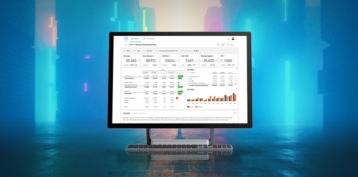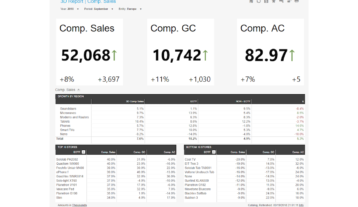Working with Hyperion: A Look at Challenges and Opportunities

Hyperion remains a popular product and still continues to be a phenomenal workhorse for enterprise reporting globally, especially insofar as it does a great job maintaining the underlying financial data. When it comes to organizing, visualizing, and making sense of that data, though, Hyperion falls short in a lot of areas. The complexity of the product’s reporting and visualization toolset, as well as its lack of workflow capabilities, causes financial teams to waste countless hours reformatting data manually in spreadsheets.
Regional Differences
For complex organizations, Hyperion falls short in presenting both detailed and consolidated views of the business. This is especially troublesome for global companies, in which regional business units often need to organize and present reports differently than their counterparts in other areas of the world.
EMEA, for example, may need to look at reports at a finer level of detail and with different organizational roll-ups than their counterparts in North America, Asia-Pacific, or Latin America. If business units are structured differently across each region, then individual profit centers and cost centers will need to be presented in ways that suit the needs of regional management.
Unfortunately, that’s not easy or cost-effective to do in Hyperion. Getting reports to mirror the organizational structure of each company across multiple regions is tedious and requires highly specialized expertise.
The alternative is also tedious: A manual, time-consuming process in which end-users extract data from Hyperion, copy it into Microsoft Excel, and build the reports there. This kind of manual copy/paste approach is error-prone and results in multiple versions of the truth. For most Hyperion users, this is the default workaround. There is a much better way, though, as I will explain a bit later.
Cumbersome Consolidations
Hyperion simply does not provide an easy method of producing clean, crisp reports for complex organizations. Customers with complicated organizational structures will find it exceedingly difficult to configure coherent reports in Hyperion that work across the entire organization.
This gets even more difficult when companies reorganize or acquire new entities. In large organizations, this kind of shuffling and reordering of reporting units happens all the time. When responsibility for a few cost centers shifts from division A to division B, making the change in Hyperion (or in the Oracle Smart View application) is far from simple.
To put it plainly, customers need a vastly more efficient way of managing their organizational structure from a reporting perspective.
No Workflow Tools
Another problem is that Hyperion lacks workflow and approval capabilities. The practical implication of this is that on a month-to-month basis, end-users must chase down key stakeholders to get them to provide numbers in a timely manner. Doing this ad hoc is a terrible waste of staff time, and it generally adds a few days to the time required to produce final reports.
Hyperion provides no way to add comments alongside the numbers either. When there is a significant variance in a particular line item, such comments provide a simple and effective means of preemptively answering questions that will inevitably come from senior management. At a time when businesses are touting the importance of transparency, the lack of such functionality is a serious shortcoming.
Performance Problems
No discussion of Hyperion would be complete without mentioning performance. Depending on the number of end-users working on Hyperion, the process of generating a report can grind to a near standstill. I have seen cases in which it took over two hours for static reports to be downloaded manually to Excel.
Performance problems in Hyperion become even more of a challenge when users are trying to extract large amounts of detailed information from the system. It is not uncommon for Hyperion to time out in those kinds of situations. This places limits on the scope of information on which users can report. Often, customers using Hyperion will resort to running the reports in stages. In many situations, for example, it may not be possible to run reports on multiple detailed scenarios in a single pass.
Many customers using Hyperion must take a bottom-up approach to building financial and managerial reports. Constructing reports by manually building up totals from the detailed data is slow and wastes valuable staff time.
Ultimately, the workaround requires users to run scenarios and comparisons at a very high level and then very slowly drill down to lower levels and subsequent passes. This is slow, extraordinarily cumbersome, and likely to introduce errors.
Real-Time Reporting: Bringing Relief to Hyperion Users
As noted earlier, Hyperion does an excellent job of managing the underlying data required for sophisticated reports. It is an outstanding tool for maintaining structured financial data and providing a single source of truth.
It is in organizing, manipulating, and presenting that information that Hyperion falls significantly short of the mark. End-users of Hyperion typically spend many hours building board packs, updating and refreshing them, and manually manipulating data in Excel spreadsheets.
All of that wasteful effort can be eliminated, though. Integrating your Hyperion solution with a real-time reporting solution that understands the underlying Hyperion infrastructure and table structure will save significant staff time and greatly enhance the performance of reports from the Hyperion database.
With the right integrated real-time reporting solution, Hyperion users no longer have to perform processor-intensive data dumps to Excel. This eliminates the primary bottleneck that typically causes performance problems in Hyperion.
Perhaps most importantly, a truly consolidated view of the business finally becomes possible. Reports can draw information from the Hyperion database in real time, presenting a top-level view of the business, with the ability to drill down to lower levels of detail, including detail at the transactional level.
At a time when most businesses are striving to be more agile, overhauling reporting tools and eliminating manual processes should be a priority. For companies running Hyperion, it’s a no-brainer.
If you would like to learn more about streamlining reporting, increasing accuracy, and saving time, contact insightsoftware for a free demo.




